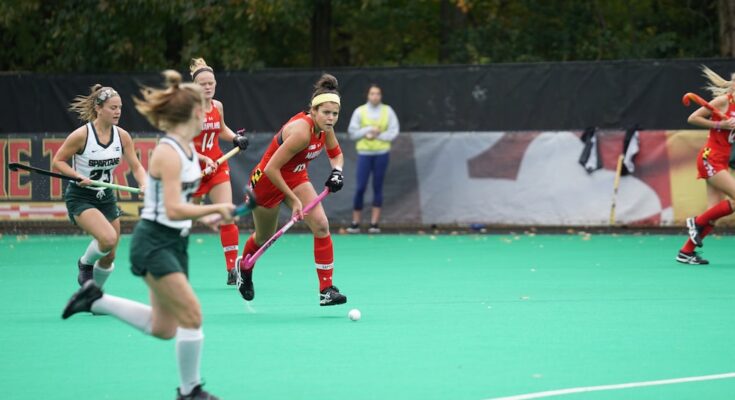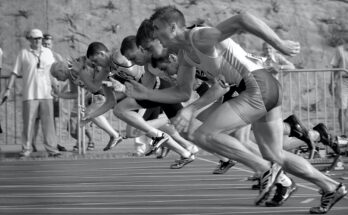Master the Art of Scoring in Field Hockey
Throwing a big hockey stick at a small, hard ball is the most pleasurable thing ever. In hockey, you can dribble, flick, roll and other things with the ball. You need some basic equipment, such as a stick and a mouthguard, to start playing. So that you may start playing, learn the game’s fundamental strategies and rules to master the game.
Safety equipment is important: master the hockey
Image via unsplash.com
These are the fundamental safety equipment requirements for hockey players. The shin guards provide a little bit more ankle protection than football shin guards but are otherwise similar. You can make them comfier by putting on socks underneath. Although mouthguards are the most crucial piece of oral protection, they always have a tendency to feel uncomfortable. You are protected against flying objects and long sticks by wearing goggles. They shield your face’s front and sides.
Online and most sporting goods retailers both sell equipment. As you learn the game, shin pads for football can be a smart place to start.
Along with a caged helmet, goalies also need some lightweight arm and leg padding.
Wearing hockey cleats: master the hockey
Field hockey games are played on grass or turf, just like in other outdoor sports like soccer and football. To prevent slippage while running, hockey shoes include tiny, rubber studs on the bottom. Pick a pair of shoes that fit comfortably without being constrictive.
Use your soccer cleats to begin if you have them. The longer studs nevertheless offer a lot of traction on the field. Special hockey studs are then an option after you get more into the sport.
Holding the hockey properly
Image via unsplash.com
The flat end of the stick should now be facing away from you. Put your left hand over the top of the stick and point your thumb downward towards the bottom, curled end. Place your right hand around the bottom of the grip, which is the portion of the stick made of black, white, or leather that extends halfway down.
For dribbling and ball control, use this simple grip.
Your thumb should be roughly in line with the stick’s curve. Grip the handle with your fingers curled around it, but be ready to adjust them sometimes as you play.
No such thing as a “lefty” stick exists. Although you can change how you hold your hands, most left-handed players hold their sticks in the same way.
Crouching with your back straight: master the hockey
The standard position for hockey players is crouching. Pushing your stick out in front of you while bending your body at the waist. Keep the stick’s curled end firmly planted on the ground and its flat end pointed outward. To be able to view the field in front of you, keep your chest raised.
Do not forward lean. To avoid back pain, bend at the waist and keep your knees slightly bent.
On the pitch, you spend the majority of your time stooping. Only when rushing after a ball or standing still do you stand up straight.
Pointing towards ball
Image via unsplash.com
Set your left foot in line with the ball as you make your aim. To provide support, put your right foot behind you. Maintain a stick’s distance between the ball and your body.
At all times, make an effort to maintain the same relationship between the ball and your body. It will be challenging to control the ball if you allow it to go too near to or too far from your body. Instead of bending your back, move in its direction if it runs away from you.
Trapping the moving ball: master the hockey
Face the ball and touch the ground with your stick. Use the rounded edge of the stick to stop the ball by placing it on the ground. You might need to take a small step backwards to slow the ball down before halting it. To stop the ball, lean the stick forward.
The ball may roll over the stick and past you if you don’t lean it forward just a little bit. You can better control the ball if you trap it, which will improve the accuracy of your passes and shots.
When receiving the ball, be gentle. Assume it is an egg. If you bump it too hard, the ball will roll away and be grabbed by the opposing team rather than breaking.
Perfecting Indian dribble
Image via unsplash.com
The ball should be in front of you, and your stick should be near to it. Flick the ball to your right while it is on your left. With your left hand, turn the stick such that the flat side is now to the right of the ball. As long as you can, flick the ball to your left and keep doing so.
This kind of dribbling is great for maintaining possession of the ball while you move.
Always use the flat side of the stick to tap the ball. Even seasoned players may struggle to grasp this approach.
First, try dribbling stationarily. Once you have mastered it, stroll up the field while dribbling.
Hook pass: master the hockey
Similar to how you stop a ball, place your stick parallel to the ground. The ball should be wrapped around the stick’s hooked end. Swing the stick forward in a single, fluid action, shifting your weight from your rear foot to your front foot.
To stay balanced and generate force, use your legs. Try not to bend forward more than is necessary to catch the ball.
You can access balls that are out of your reach by using the hook pass. Keep practicing even though it probably won’t feel as accurate at first as sweep passes!
Performing slap shot
Image via unsplash.com
Keep your left hand wrapped around the top of the stick as you stand with the ball in front of you. While raising your right hand, hold onto your stick firmly. To begin your swing, bring your stick back behind you. Put your weight on your front foot as you extend your stick.
This type of club swing is comparable to driving a ball far in cricket or golf. Instead of attempting to hit the ball with force, push the ball on the ground for more precision.
Keep in mind that you can only shoot the ball from inside the scoring circle by striking it with the flat section of your stick.









